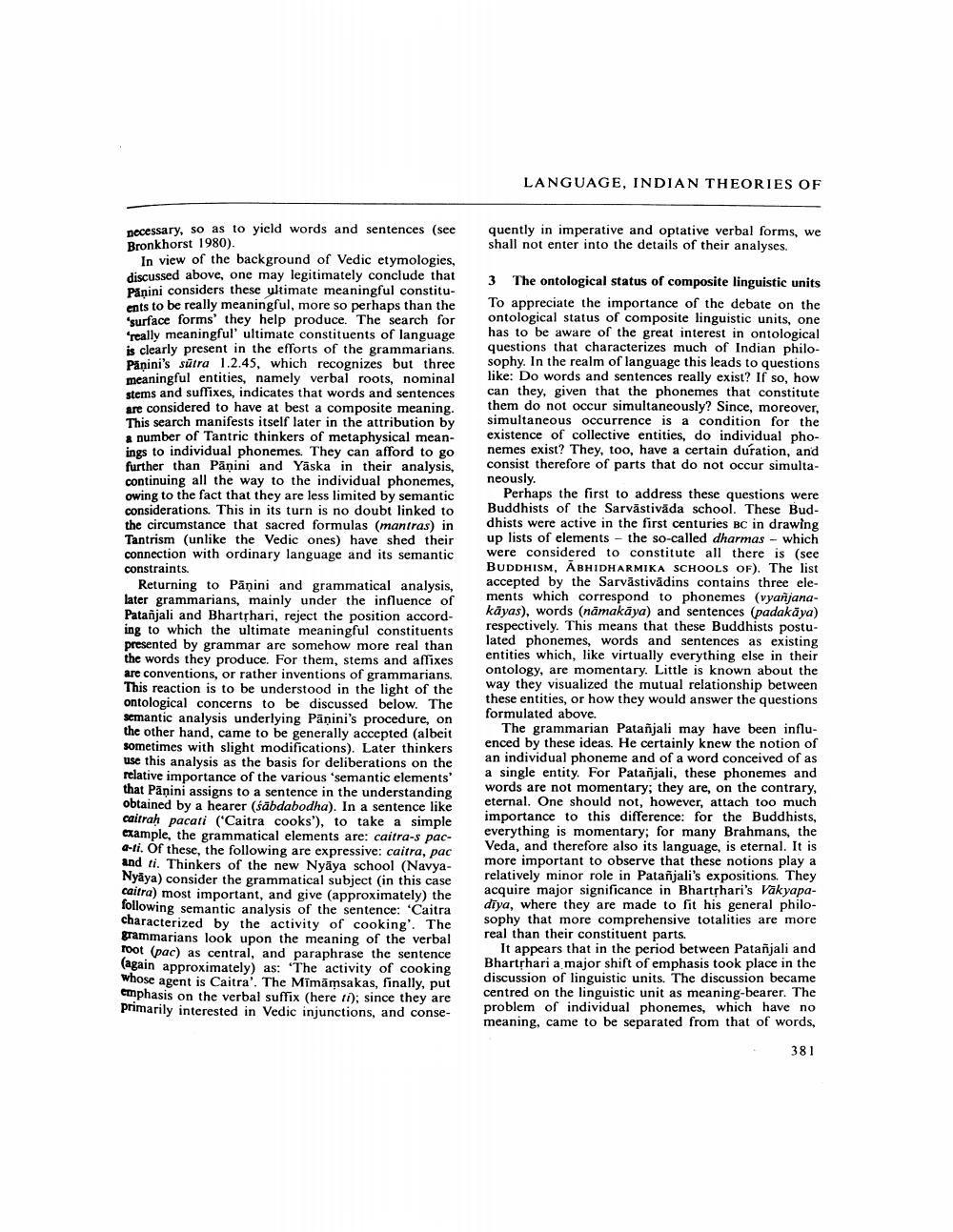Book Title: Language Indian Theories Of Author(s): Johannes Bronkhorst Publisher: Johannes Bronkhorst View full book textPage 3
________________ LANGUAGE, INDIAN THEORIES OF quently in imperative and optative verbal forms, we shall not enter into the details of their analyses. pecessary, so as to yield words and sentences (see Bronkhorst 1980). In view of the background of Vedic etymologies, discussed above, one may legitimately conclude that Pånini considers these ultimate meaningful constituents to be really meaningful, more so perhaps than the "surface forms' they help produce. The search for 'really meaningful' ultimate constituents of language is clearly present in the efforts of the grammarians. Panini's sūtra 1.2.45, which recognizes but three meaningful entities, namely verbal roots, nominal stems and suffixes, indicates that words and sentences are considered to have at best a composite meaning. This search manifests itself later in the attribution by a number of Tantric thinkers of metaphysical meanings to individual phonemes. They can afford to go further than Panini and Yāska in their analysis, continuing all the way to the individual phonemes, owing to the fact that they are less limited by semantic considerations. This in its turn is no doubt linked to the circumstance that sacred formulas (mantras) in Tantrism (unlike the Vedic ones) have shed their connection with ordinary language and its semantic constraints. Returning to Panini and grammatical analysis, later grammarians, mainly under the influence of Patanjali and Bhartrhari, reject the position according to which the ultimate meaningful constituents presented by grammar are somehow more real than the words they produce. For them, stems and aflixes are conventions, or rather inventions of grammarians. This reaction is to be understood in the light of the ontological concerns to be discussed below. The Semantic analysis underlying Panini's procedure, on the other hand, came to be generally accepted (albeit sometimes with slight modifications). Later thinkers use this analysis as the basis for deliberations on the relative importance of the various 'semantic elements' that Panini assigns to a sentence in the understanding obtained by a hearer (śäbdabodha). In a sentence like caitrah pacati ('Caitra cooks'), to take a simple cxample, the grammatical elements are: caitra-s paca-ti. Of these, the following are expressive: caitra, pac and ti. Thinkers of the new Nyāya school (NavyaNyaya) consider the grammatical subject in this case caitra) most important, and give (approximately) the following semantic analysis of the sentence: 'Caitra characterized by the activity of cooking'. The grammarians look upon the meaning of the verbal root (pac) as central, and paraphrase the sentence (again approximately) as: 'The activity of cooking whose agent is Caitra'. The Mimāmsakas, finally, put emphasis on the verbal suffix (here tl); since they are primarily interested in Vedic injunctions, and conse 3 The ontological status of composite linguistic units To appreciate the importance of the debate on the ontological status of composite linguistic units, one has to be aware of the great interest in ontological questions that characterizes much of Indian philosophy. In the realm of language this leads to questions like: Do words and sentences really exist? If so, how can they, given that the phonemes that constitute them do not occur simultaneously? Since, moreover, simultaneous occurrence is a condition for the existence of collective entities, do individual phonemes exist? They, too, have a certain duration, and consist therefore of parts that do not occur simultaneously. Perhaps the first to address these questions were Buddhists of the Sarvāstivāda school. These Buddhists were active in the first centuries Bc in drawing up lists of elements - the so-called dharmas - which were considered to constitute all there is (see BUDDHISM, ABHIDHARMIKA SCHOOLS OF). The list accepted by the Sarvästivādins contains three elements which correspond to phonemes (vyanjanakayas), words (namakaya) and sentences (padakaya) respectively. This means that these Buddhists postulated phonemes, words and sentences as existing entities which, like virtually everything else in their ontology, are momentary. Little is known about the way they visualized the mutual relationship between these entities, or how they would answer the questions formulated above. The grammarian Patañjali may have been influenced by these ideas. He certainly knew the notion of an individual phoneme and of a word conceived of as a single entity. For Patanjali, these phonemes and words are not momentary: they are, on the contrary, eternal. One should not, however, attach too much importance to this difference: for the Buddhists, everything is momentary: for many Brahmans, the Veda, and therefore also its language, is eternal. It is more important to observe that these notions play a relatively minor role in Patañjali's expositions. They acquire major significance in Bharthari's Vakyapadīya, where they are made to fit his general philosophy that more comprehensive totalities are more real than their constituent parts. It appears that in the period between Patanjali and Bhartrhari a major shift of emphasis took place in the discussion of linguistic units. The discussion became centred on the linguistic unit as meaning-bearer. The problem of individual phonemes, which have no meaning, came to be separated from that of words, 381Page Navigation
1 2 3 4 5 6
